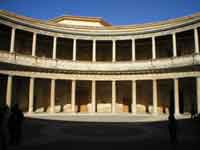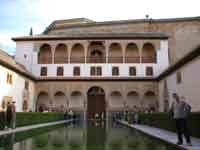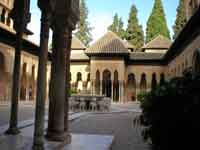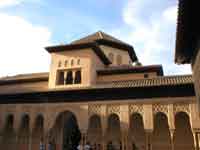The Alhambra, a vast area of palaces and gardens built during the 14th century Nazari dynasty, is universally acclaimed for it’s architecture and beauty. It is one of the most popular sites in Spain and should definitely be on your list of ‘must see’ places. The Alhambra stands at the foot of the Sierra Nevada mountains and overlooks the city of Granada.
The name Alhambra is Arabic in origin, meaning ‘red or crimson castle’. It was originally designed for military purposes and was an alcazaba (fortress), an alcázar (palace) and a medina (city), all rolled in one.
The Alhambra did not become a royal residence until the 13th century, a though the fortress had existed since the 9th century. The first kings of Granada built their castles and palaces on the hill of the Albaicin.


The founder of the Nazari dynasty, Muhammed Al-Ahmar, came to power in 1232 and in 1238 began restoring the old fortress. The work was completed by his son Muhammed II. There were frequent additions and alterations carried out over the years by various rulers of the kingdom.
The construction of the palaces (Casa Real Vieja, ‘old Royal House or Palace’) dates back to the 14th century and is the work of Yusuf I and Muhammed V. Yusuf I was responsible for the Cuarto de Comares (Chamber of Comares), the Puerta de la Justicia (Gate of Justice), the Baths and some of the towers. His son, Muhammed V, completed the decoration of the palaces along with the Cuarto de los Leones (Chamber of the Lions).


The Alhambra became a Christian court in 1492 after the Catholic Monarchs Ferdinand and Isabella re-conquered the city. Later, various structures were built for prominent civilians and there were military garrisons, a church and a Franciscan monastery.
Emperor Charles V began the construction of the palace which bears his name and also made alterations to the interior of some of the buildings.
The Alhambra fell into neglect during the 18th and 19th centuries. and Napoleon’s troops, stationed in Granada from 1808 until 1812, converted the palaces into barracks. Forced to retreat on one occasion, they mined the towers the Torre de Siete Suelos and the Torre de Agua were left in ruins. The period of neglect continued until 1870 when the Alhambra was declared a national monument. Since then, the Alhambra has been protected, restored and improved.,
The Alcazaba is the oldest part of the Alhambra, built upon the ruins of a castle in the 9th century. The most solid towers are the Homenaje, to the south, and the Quebrada at the northeast angle. The most elaborate interior is the Torre de las Armas, but the most impressive is the Torre de la Vela, whose bell is rung on special festive occasions by young girls in the hope of warding off spinsterhood
At the entrance to the Alcazaba is the Jardín de los Adarves, also known as the Jardin de los Poetas. Nice place for a gentle stroll.
La Casa Real (The royal house or palace) comprises several palace groups surrounded by a series of courts and other structures. Since the 16th century these palaces have been designated the Casa Real Vieja (Old Royal House) in order to distinguish them from the later Christian buildings.
The Alhambra contains the three divisions usually associated with a Moslem palace, including a reception salon and the royal apartments. The Chamber of the Lions is the work of Muhammed V and illustrates the beauty of Granada Moslem art.
The Court of the Lions is a grove of 124 palm trees, most with double columns, around a central fountain with twelve lions. The twelve-sided marble fountain rests upon the backs of the lions. An ode by Ibn Zamrak can be seen on the rim of the basin.
Four large halls border the courtyard. The first, entering from the Court of the Myrtles, is the Sala de los Mozárabes. To the south is the Sala de Abencerrajes, with a gateway decorated with ornamental knots. Light enters the hall through 16 fretwork windows. To the east is the unusual Sala de los Reyes, which is divided into three sections. It has three porticos, separated by double arches of mozárabes (stalactites).
North of the Court of the Lions is the Sala de las Dos Hermanas, so called because of the two large marble flagstones flanking the central fountain and spout. The adjoining hall is the Sala de los Ajimeces. Two balconies overlook the Garden of Daraxa. Between these two balconies is the Mirador de Daraxa, dressing room and bedroom of the Sultana.
The last hall gives access to the Peinador de la Reina, an open gallery and a small tower designed as the residence of the Empress Isabel and later of Isabel of Parma. Some restored frescoes portray scenes of Charles V’s expedition to La Goleta.
The Church of St Mary is built upon the site where the royal mosque formerly stood. The Monastery of St Francis, which is now a parador, was erected upon an Arab palace and housed the temporary sepulchre of the Catholic Monarchs Ferdinand and Isabella.
The Palacio de Carlos V or Casa Real Nueva was commissioned by the Emperor in an attempt to emulate the Palace of the defeated Moslems and well as to provide for himself a habitable residence. Construction began in 1527 under the direction of Pedro Machuca, who had studied with Michelangelo in Italy. The palace is built in the form of a square and comprised of two main parts: the first, in Tuscan style, and the second with Ionic pillars.
Upon entry to the Alhambra you will be assigned a time slot for the Palace, failure to enter during this half hour time slot means will be denied entry to this complex. Enter the Alhambra well before your assigned time and visit other sections of the Alhambra beforehand. To see everything will take about 3 hours.
Tickets for the Alhambra
The number of admissions per day is limited in order to protect the monument. If you have not booked in advance it is imperative to turn up early, especially during high season. Queues will start well before the 8.30 opening time.
